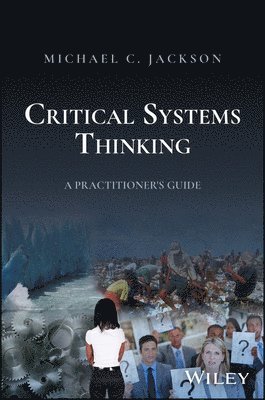
- Format
- Inbunden (Hardback)
- Språk
- Engelska
- Antal sidor
- 256
- Utgivningsdatum
- 2024-06-19
- Förlag
- John Wiley & Sons Inc
- Dimensioner
- 218 x 150 x 23 mm
- Vikt
- Antal komponenter
- 1
- ISBN
- 9781394203574
- 295 g
Critical Systems Thinking
A Practitioner's Guide
- Skickas från oss inom 5-8 vardagar.
- Fri frakt över 249 kr för privatkunder i Sverige.
Passar bra ihop
De som köpt den här boken har ofta också köpt The SWOT Analysis: Using your Strength to overc... av Lawrence G Fine (häftad).
Köp båda 2 för 724 krKundrecensioner
Fler böcker av Michael C Jackson
-
Systems Approaches to Management
Michael C Jackson
-
Systems Thinking
Michael C Jackson
-
Creative Problem Solving
Robert L Flood, Michael C Jackson
-
Systems Methodology for the Management Sciences
Michael C Jackson
Övrig information
Dr Michael C. Jackson is an established expert in systems thinking and the major figure in the development of CST. He is Emeritus Professor, and former Dean of the Business School, University of Hull, UK, and Managing Director of Systems Research Ltd. He has served as President of the International Federation for Systems Research and the International Society for the Systems Sciences. He was awarded an OBE by Her Majesty the Queen (2011) for services to business and higher education, the Beale Medal of the UK Operational Research Society (2017), and the Pioneer Award of the International Council on Systems Engineering (2022). His previous book for Wiley, Critical Systems Thinking and the Management of Complexity (2019), is regarded as the definitive account of the history of systems thinking and the different systems methodologies.
Innehållsförteckning
Preface xi Acronyms xv Introduction xvii Part 1 The Emergence of Critical Systems Thinking 1 1 The Scientific Method 3 1.1 Introduction 3 1.2 Early Systems Thinking 4 1.3 The Ascendancy of the Scientific Method 5 1.4 Romanticism and Disquiet 7 1.5 The Challenge of Complexity 10 1.6 Science and the Scientific Method in the Spotlight 13 1.7 Conclusion 15 References 17 2 Systems Thinking 19 2.1 Introduction 19 2.2 The Challenge Confronting Systems Thinking 20 2.3 Complexity and Wicked Problems 21 2.4 The Search for General Systems Laws 24 2.4.1 Bogdanov and Tektology 24 2.4.2 Von Bertalanffy and General Systems Theory 25 2.4.3 Wiener and Cybernetics 27 2.4.4 Complexity Theory 30 2.5 The Problem of Emergence 34 2.6 A Pluralistic Approach to the Use of Systems Thinking 38 2.7 The Development of Systems Methodologies 39 2.8 Conclusion 41 References 42 3 Critical Systems Thinking 47 3.1 Introduction 47 3.2 The Origins and Early Development of Critical Systems Thinking 48 3.3 Systemic Critique 50 3.4 Systemic Pluralism 52 3.5 Systemic Improvement 53 3.6 The Argument for Systemic Pragmatism 55 3.6.1 From Paradigms to Pragmatism 55 3.6.2 What Is Pragmatism? 56 3.6.3 Towards Systemic Pragmatism 59 3.7 Conclusion 64 References 64 Part 2 Critical Systems Practice 69 4 Critical Systems Practice: An Overview 71 4.1 Introduction 71 4.2 The Origins of Critical Systems Practice 71 4.3 Contemporary Critical Systems Practice 72 4.3.1 Essence 72 4.3.2 The EPIC Framework 73 4.3.3 The Four Stages 73 4.3.3.1 Explore the Situation of Interest 73 4.3.3.2 Produce an Intervention Strategy 75 4.3.3.3 Intervene Flexibly 76 4.3.3.4 Check on Progress 76 4.4 Considerations on the Nature of Critical Systems Practice 77 4.5 Related Approaches 79 4.6 Conclusion 82 References 82 5 Critical Systems Practice 1 Explore the Situation of Interest 85 5.1 Introduction 85 5.2 Explore Preliminaries 85 5.2.1 Metaphors and World Hypotheses in Philosophy 87 5.2.2 Paradigms and Metaphors in Organisation Theory 89 5.2.3 Multiperspectival Approaches in Systems Thinking 91 5.3 Explore Process 91 5.3.1 View the Situation of Interest from Five Systemic Perspectives 92 5.3.1.1 The Mechanical Systemic Perspective 93 5.3.1.2 The Interrelationships Systemic Perspective 94 5.3.1.3 The Organismic Systemic Perspective 95 5.3.1.4 The Purposeful Systemic Perspective 97 5.3.1.5 The Societal/Environmental Systemic Perspective 99 5.3.2 Identify Primary and Secondary Issues 100 5.4 Explore Example: The Early Days of the COVID- 19 Pandemic in the United Kingdom 101 5.5 Explore Issues 106 5.6 Conclusion 109 References 110 6 Critical Systems Practice 2 Produce an Intervention Strategy 113 6.1 Introduction 113 6.2 Produce Preliminaries 114 6.3 Produce Process 115 6.3.1 Appreciate the Variety of Systems Approaches 115 6.3.2 Choose Appropriate Systems Methodologies 118 6.3.2.1 Engineering Systems Methodologies 118 6.3.2.2 System Dynamics 122 6.3.2.3 Living Systems Methodologies 127 6.3.2.4 Soft Systems Methodologies 134 6.3.2.5 Emancipatory Systems Methodologies 141 6.3.3 Choose Appropriate Systems Models and Methods 145 6.3.4 Structure, Schedule and Set Objectives for the Intervention 145 6.4 Produce Examples 146 6.5 Produce Issues 149 6.6 Conclusion 152 References 153 7 Critical Systems Practice 3 Intervene Flexibly 159 7.1 Introduction 159 7.2 Intervene Preliminaries 159 7.3 Intervene Process 160 7.3.1 Use Systems Methodologies, Models and Methods Flexibly 160 7.3.2 Stay Alert to the Evolving Situation (Revisit Stage 1) 160 7.3.3 Stay Flexible About Appropriate Methodologies, Models and Methods (Revisit Stage 2) 160 7.4 Intervene Examples 162 7.5 Intervene Issues 169 7.6 Conclusion 170 References 170 8 Critical Systems Practice 4


